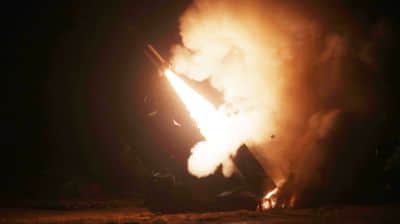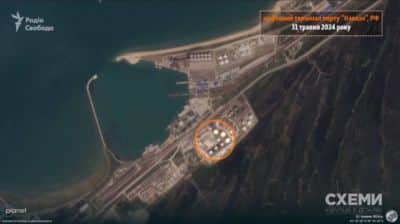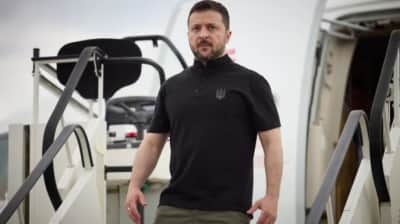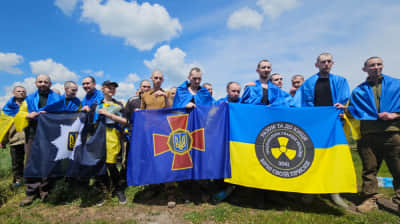Russians advance no more than 8 km from border in northern Kharkiv Oblast – ISW
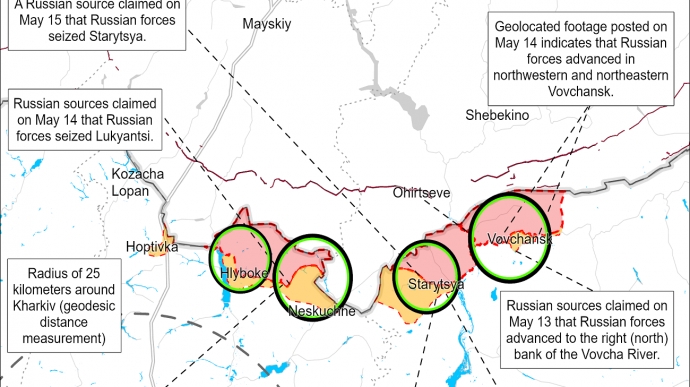
The Institute for the Study of War (ISW) has estimated that the Russians have advanced no more than eight kilometres from the border in the northern part of Kharkiv Oblast and intend to establish a "buffer zone" rather than advance deeper.
Source: ISW
Details: ISW noted that the pace of Russian offensive operations in the northern part of Kharkiv Oblast has continued to decrease after the Russians initially occupied areas that, as now confirmed by Ukrainian officials, were less defended.
Ukrainian President Volodymyr Zelenskyy and Ukrainian military officials stated that Ukrainian forces have partially stabilised the situation in the northern part of Kharkiv Oblast, which borders Russia.
Nazar Voloshyn, spokesperson for the Khortytsia Operational Strategic Group, stated that Russian forces are trying to achieve tactical successes near the settlements of Lukiantsi and Vovchansk to establish footholds for further advancement, but Ukrainian counterattacks, shelling and drone strikes were preventing Russian forces from consolidating in these areas.
The Kharkiv Oblast Administration representatives stated on 15 May that constant Russian attacks were preventing Ukrainian forces from establishing fortifications within three to five kilometres from the border with Russia in Kharkiv Oblast. They added that Ukrainian forces have constructed the first and second lines of defence at distances of 12-13 kilometres and 20 kilometres from the border, respectively.
ISW estimates show that Russian forces have advanced at most eight kilometres from the border in the northern part of Kharkiv Oblast.
The forces operating on Russian territory can easily deliver artillery strikes on Ukrainian defensive positions near the border. However, restrictions on the use of Western-provided weapon systems to strike rear Russian areas across the border make stationary Ukrainian defensive positions near the border vulnerable and possibly defenceless.
Russian forces have achieved tactical successes in the northern part of Kharkiv Oblast since 10 May in areas where Ukrainian forces have deliberately not created significant defensive lines. It appears that the Russians are currently preferring to create a "buffer zone" rather than advance deeper into Kharkiv Oblast.
To quote the ISW’s Key Takeaways on 15 May:
- The tempo of Russian offensive operations in northern Kharkiv Oblast continues to decrease after Russian forces initially seized areas that Ukrainian officials have now confirmed were less defended.
- The US Helsinki Commission stated that the US should allow Ukraine to conduct strikes against military targets in Russia's border areas amid an ongoing Russian offensive operation into Kharkiv Oblast from Russia, although US officials continue to express unwillingness to support such strikes.
- Russian leader Vladimir Putin continues to publicly prioritise the further mobilisation of the Russian defence industrial base (DIB) while also attempting to assuage possible domestic fears about the negative effects of increased Russian defence spending.
- Putin specifically noted that the Russian DIB must increase the quality of Russian weapons.
- Putin is likely concerned about the economic and diplomatic implications of decreased Russian arms exports.
- The Kremlin confirmed the appointments of the newly formed Moscow and Leningrad military districts (MMD and LMD) and other military district commanders on 15 May.
- US Secretary of State Antony Blinken announced during a joint press conference with Ukrainian Foreign Minister Dmytro Kuleba on 15 May that the US will provide a two billion dollar "defence enterprise fund" to Ukraine.
- Ukraine's Main Military Intelligence Directorate (GUR) reportedly struck a Russian fuel depot in Rostov Oblast on the night of 14 to 15 May.
- The Kremlin continues to add European officials to Russia's wanted list as part of Russia's efforts to assert the jurisdiction of Russian federal law over sovereign NATO member states.
- Russian forces recently made confirmed advances in northern Kharkiv Oblast, near Siversk, and west of Donetsk City.
- Ukrainian National Security and Defence Council Secretary Oleksandr Lytyvyenko assessed on 15 May that Russian forces will have enough tanks and armoured fighting vehicles for the next year and half of fighting in Ukraine at their current operational tempo.
Support UP or become our patron!



